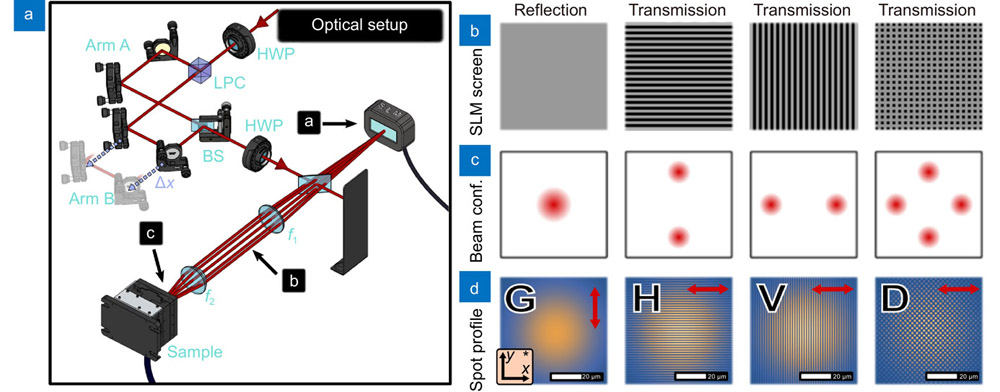Fotis Fraggelakis, George D. Tsibidis, Emmanuel Stratakis. Ultrashort pulsed laser induced complex surface structures generated by tailoring the melt hydrodynamics[J]. Opto-Electronic Advances, 2022, 5(3): 210052
Search by keywords or author
- Opto-Electronic Advances
- Vol. 5, Issue 3, 210052 (2022)

Fig. 1. (a ) Experimental setup. Abbreviations: half-wave plate (HWP), linear polarizing cube (LPC), beam splitter (BS), spatial light modulator (SLM), focusing lenses (f1,f2). (b ) SLM function. (c ) Spot profile distribution at the sample: Gaussian (G) and DLIP (V, H, D) profiles. (d ) The red arrow indicates the polarisation vector.

Fig. 2. a ) G1= 1, G2= 0 and (b ) G1= 0, P2=1, after irradiating a flat profile (NP= 1) with E= 25 μJ, Δτ = 500 ps. (c )
Fig. 3. (a ) Spot intensity distribution. (b ) SEM images of processed surface. (c ) Fourier transform diagrams, produced by trains of single pulses. The total number of pulses is NP = 50, the energy per pulse is Etot = 80 μJ for G, and Etot = 57 μJ for the DLIP distribution V, H and D. The red arrow in A indicates the polarisation direction.
Fig. 4. SEM images of the double pulse irradiation schemes used (1st column) together with the respective FFT analyses (2nd column) and simulation results (columns 3−5). The pulse profile and the order are indicated in the legends of the 1st column, while the superscript arrows indicate the pulse polarization in each case. The total energy of the double pulse pair is 80 μJ/pulse and NP = 50 pulses. Simulation results are shown in each case, just before (3rd column, Δ
Fig. 5. Stainless steel surface morphology following variation in pulse energy and NP, as indicated in the respective legends, for the D+ G pulse sequence case. The corresponding result of theoretical simulations for 20 μJ pulse energy is shown as an inset defined by the dashed rectangle, illustrating (i ) the temperature profile for NP = 50 and t = 520 ps and (ii ) the final surface morphology for NP = 50.
Fig. 6. Complex structures generated with Etot = 70 μJ, NP = 100 with the D+G pulse sequence irradiation scheme. The SEM image is analysed with FFT and reconstructed surfaces comprising structures at different length scales are illustrated. The areas corresponding to the different periodicities are highlighted in FFT diagrams.
Fig. 7. Simulation results showing the surface temperature profile obtained for the G+V case at different time moments and NP, as indicated. The arrows in the figures in the zoomed regions illustrate the spatial distribution of the magnitude and direction of the calculated fluid velocity vectors.

Set citation alerts for the article
Please enter your email address



